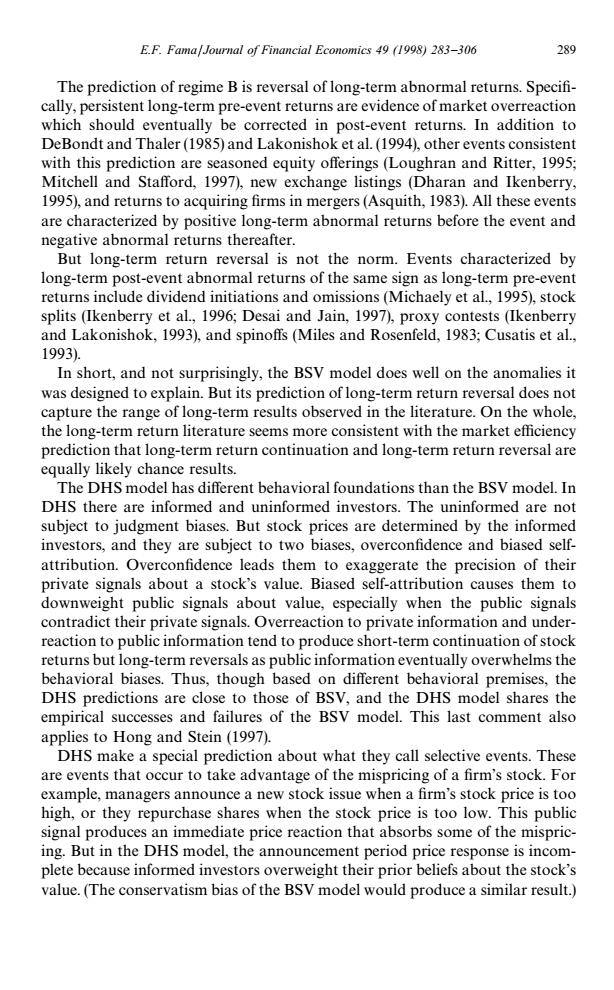正在加载图片...

E.F.FamafJournal of Financial Economics 49 (1998)283-306 289 The prediction of regime B is reversal of long-term abnormal returns.Specifi- cally,persistent long-term pre-event returns are evidence of market overreaction which should eventually be corrected in post-event returns.In addition to DeBondt and Thaler(1985)and Lakonishok et al.(1994),other events consistent with this prediction are seasoned equity offerings(Loughran and Ritter,1995; Mitchell and Stafford,1997),new exchange listings(Dharan and Ikenberry, 1995),and returns to acquiring firms in mergers(Asquith,1983).All these events are characterized by positive long-term abnormal returns before the event and negative abnormal returns thereafter. But long-term return reversal is not the norm.Events characterized by long-term post-event abnormal returns of the same sign as long-term pre-event returns include dividend initiations and omissions(Michaely et al.,1995),stock splits(Ikenberry et al,1996;Desai and Jain,1997),proxy contests(Ikenberry and Lakonishok,1993),and spinoffs (Miles and Rosenfeld,1983;Cusatis et al. 1993. In short,and not surprisingly,the BSV model does well on the anomalies it was designed to explain.But its prediction of long-term return reversal does not capture the range of long-term results observed in the literature.On the whole, the long-term return literature seems more consistent with the market efficiency prediction that long-term return continuation and long-term return reversal are equally likely chance results. The DHS model has different behavioral foundations than the BSV model.In DHS there are informed and uninformed investors.The uninformed are not subject to judgment biases.But stock prices are determined by the informed investors,and they are subject to two biases,overconfidence and biased self- attribution.Overconfidence leads them to exaggerate the precision of their private signals about a stock's value.Biased self-attribution causes them to downweight public signals about value,especially when the public signals contradict their private signals.Overreaction to private information and under- reaction to public information tend to produce short-term continuation of stock returns but long-term reversals as public information eventually overwhelms the behavioral biases.Thus,though based on different behavioral premises,the DHS predictions are close to those of BSV,and the DHS model shares the empirical successes and failures of the BSV model.This last comment also applies to Hong and Stein(1997). DHS make a special prediction about what they call selective events.These are events that occur to take advantage of the mispricing of a firm's stock.For example,managers announce a new stock issue when a firm's stock price is too high,or they repurchase shares when the stock price is too low.This public signal produces an immediate price reaction that absorbs some of the mispric- ing.But in the DHS model,the announcement period price response is incom- plete because informed investors overweight their prior beliefs about the stock's value.(The conservatism bias of the BSV model would produce a similar result.)The prediction of regime B is reversal of long-term abnormal returns. Specifi- cally, persistent long-term pre-event returns are evidence of market overreaction which should eventually be corrected in post-event returns. In addition to DeBondt and Thaler (1985) and Lakonishok et al. (1994), other events consistent with this prediction are seasoned equity offerings (Loughran and Ritter, 1995; Mitchell and Stafford, 1997), new exchange listings (Dharan and Ikenberry, 1995), and returns to acquiring firms in mergers (Asquith, 1983). All these events are characterized by positive long-term abnormal returns before the event and negative abnormal returns thereafter. But long-term return reversal is not the norm. Events characterized by long-term post-event abnormal returns of the same sign as long-term pre-event returns include dividend initiations and omissions (Michaely et al., 1995), stock splits (Ikenberry et al., 1996; Desai and Jain, 1997), proxy contests (Ikenberry and Lakonishok, 1993), and spinoffs (Miles and Rosenfeld, 1983; Cusatis et al., 1993). In short, and not surprisingly, the BSV model does well on the anomalies it was designed to explain. But its prediction of long-term return reversal does not capture the range of long-term results observed in the literature. On the whole, the long-term return literature seems more consistent with the market efficiency prediction that long-term return continuation and long-term return reversal are equally likely chance results. The DHS model has different behavioral foundations than the BSV model. In DHS there are informed and uninformed investors. The uninformed are not subject to judgment biases. But stock prices are determined by the informed investors, and they are subject to two biases, overconfidence and biased selfattribution. Overconfidence leads them to exaggerate the precision of their private signals about a stock’s value. Biased self-attribution causes them to downweight public signals about value, especially when the public signals contradict their private signals. Overreaction to private information and underreaction to public information tend to produce short-term continuation of stock returns but long-term reversals as public information eventually overwhelms the behavioral biases. Thus, though based on different behavioral premises, the DHS predictions are close to those of BSV, and the DHS model shares the empirical successes and failures of the BSV model. This last comment also applies to Hong and Stein (1997). DHS make a special prediction about what they call selective events. These are events that occur to take advantage of the mispricing of a firm’s stock. For example, managers announce a new stock issue when a firm’s stock price is too high, or they repurchase shares when the stock price is too low. This public signal produces an immediate price reaction that absorbs some of the mispricing. But in the DHS model, the announcement period price response is incomplete because informed investors overweight their prior beliefs about the stock’s value. (The conservatism bias of the BSV model would produce a similar result.) E.F. Fama/Journal of Financial Economics 49 (1998) 283—306 289